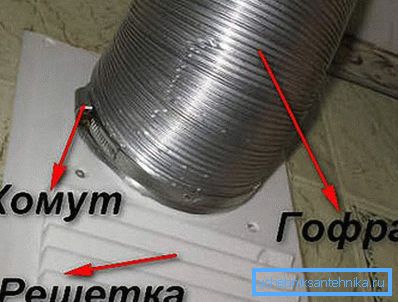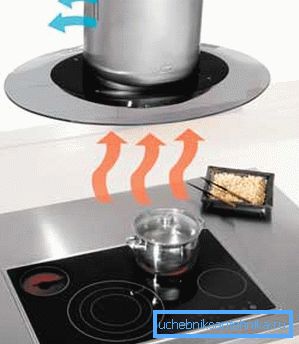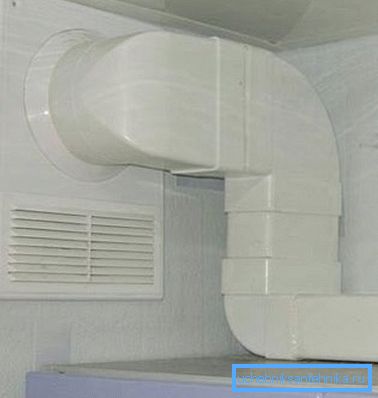Pipe for exhaust and some features of its installation
Ventilation for living rooms of apartments and houses is one of the most important communications. It guarantees not only comfort, but also has a serious impact on the health of all residents. One of the means of the ventilation system, which ensures the comfort of living in the house, is the kitchen hood and the quality of its work directly depends on how well the ventilation pipe is installed for the hood.

Selecting and purchasing the equipment itself is not a difficult task. Difficulties may begin during the installation process.
Many begin to worry about how to hang the hood if the gas pipe interferes or if the ventilation duct is very far from the kitchen stove. It is in order to solve such problems and there are specialized pipes for hoods.
Some features of the design of the duct

Outside the room, air can be discharged using the following methods:
- By means of an air duct, if we are talking about an apartment;
- Through the hole in the wall of the house to the outside, if we are talking about a private structure. In this case, even a separate pipe on the roof for exhaust can be removed.
Architects and house designers usually provide for the location of the ventilation channel directly above the kitchen stove, but in high-rise buildings of typical design, the location of such kitchen equipment does not always correspond to the location of the ventilation channel.
The only solution in such situations can only be a ventilation pipe for a kitchen hood in order to connect it to the ventilation duct.
Council It is not recommended to install a stove, and, accordingly, the hood against the wall opposite to the ventilation duct, as in this case, the pipeline will have a large length and multiple bends, which will negatively affect the efficiency of the equipment.
Well, if you connect the hood to the duct or the hole in the wall is not possible, then you can purchase such a device as a hood without a pipe, which is equipped with a filter system and does not require output to the external environment.

Main types of pipes
Ventilation pipes or, as they are also called, air ducts are usually represented by two types:
- Smooth galvanized and plastic pipes for exhaust;
- Corrugated from plastic or rigid aluminum.
Smooth ducts
Smooth ducts depending on the cross section can be of two types:
- Round ducts;
- Flat tubes for exhaust.
Note! Flat rectangular products are less noticeable in the interior, in contrast to the bulk structures of circular cross section.

Installation is usually carried out on the cabinets of the kitchen unit, which makes them almost invisible.
In order to make installation of plastic structures you need not only the device and pipes, but also plastic L-shaped adapters, an adapter from the hood to the duct and from the duct to the duct of the ventilation system.
Council All connections for the purpose of hardening and sealing are made using a sealant.
The use of plastic products has several advantages:
- Extraneous sounds and noises during the operation of the hood are reduced to a minimum level;
- Exhaust construction is devoid of gaps, which may eventually become a place of accumulation of fat and dirt.
Features of the use of corrugated ducts

Fasteners of this kind of products are made using clamps and gratings equipped with specialized fasteners, called fittings.
In order to determine the length of the product it is necessary to stretch it as much as possible, because wrinkles on the surface can cause noisy work of the hood.
The advantages of using such products include ease of installation and the absence of the need to purchase additional elements to ensure bending. In addition, the price of such materials is several times lower than that of plastic.
Choice of diameter and design of the duct
Ventilation pipes for kitchen hoods are selected no less than the diameter of the exhaust hole. Otherwise, the performance of the device will be reduced to a minimum and the noise level will increase markedly. In addition, the wrong diameter will lead to a large load on the motor, which can lead to its premature failure.
Next we look at how to install a pipe for the hood. The instruction stipulates first of all that it should not be too long and have many turns.
Each turn of the duct by 90 degrees reduces the system performance by approximately 10%. Well, in the event that the bend will exceed the given parameters of the angle, this may cause incorrect movement of the air flow, which will lead to an overload of the motor.
In order to prevent the duct from moving in the opposite direction, valves must be installed from the ventilation duct to the duct.
They are of two main types:
- Axial with plastic disc;
- Filmy.
Installing the hood with your own hands, you need to know that the optimal length of the duct is not more than 3 m. Each subsequent meter will reduce the efficiency of the system by 5-10%.
Council Manufacturers of hoods recommend to use materials of circular cross section for connection to the ventilation duct. A square exhaust duct has a lower capacity.
Masking methods

The visible pipe for the kitchen hood is a spectacle of not very ennobling interior, so after installation many owners try to hide it from sight by all means.
In addition to the fact that the already mentioned kitchen cupboard cabinets can hide the air duct, there are several other masking methods:
- If the installation is planned just at the time of the repair work, you should look at the ceiling. If it is planned to sheathe sheets of drywall, then you may well ask the workers to provide for the creation of a box in which to arrange the structure.
- If you plan to build a multi-level ceiling structure, the duct fits perfectly on the lower level. If you are planning the arrangement of the stretch ceiling, then the pipeline can be hidden behind it;
- If the installation is planned after the repair work, then a special decorative pipe or a decorative plastic box can be selected for its installation.. Boxes of this kind come in various colors, shapes and sizes, even small lamps can be located on their surface;
- If the question of aesthetics is particularly acute, then you can acquire a built-in extractor hood, which is mounted directly in the kitchen furniture, and in this case the pipe will also be hidden in it;
- If none of the proposed options is suitable for you, then the design can be simply painted to match the finish or show enough imagination and decorate the duct in an original way, making it an integral part of the design.
Finally
A kitchen hood is an important and necessary attribute in every kitchen, so it is important that it work properly and efficiently. It is for this purpose that it is necessary to select the location of the slab, with the possibility of providing air extraction (see also the article Pipes from cross-linked polyethylene as a modern material of advanced plumbing).
Well, if the hood is already purchased, pick up the duct will not be difficult. On the market, both plastic and corrugated exhaust pipes can be purchased, with the installation of which you can easily manage on your own. The main thing is that the resulting system remains tight and efficient.
The video in this article will be for you an excellent visual aid for how to install the duct to the hood in the kitchen.